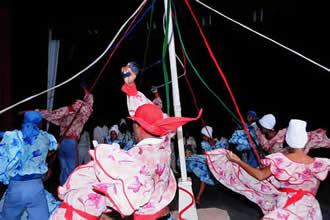Turandot, Giacomo Puccini’s last opera, was left incomplete at the composer’s death. It is rarely heard in North Carolina and nearby states. Charlotte’s wonderful European horseshoe-style Belk Theater was packed with a very diverse audience for the richly satisfying Opera Carolina production of the version completed by Franco Alfano. Flexible and sparse set elements served to keep the focus on characterization and gorgeous singing, which a strong cast delivered in spades. Like Russian operas, such as Borodin’s Prince Igor and Mussorgsky’s Boris Godunov, the chorus is as important as any of the principal singers in a successful Turandot.
The leading roles were cast from strength with experienced, outstanding young singing actors with no evident weaknesses. Clarity of diction and power of vocal projection were exemplary. It was clear Puccini would get his due from the vocal power and visual impact of baritone John Fortson as the Mandarin. Clothed in striking yellow robes and standing in a tower a head above the chorus on stage, he delivered his stentorian lines with authority. The role of the blind, exiled Tartar King Timur gave bass Dan Boye a chance to shine with some major solo music. The Davidson College physics professor is a popular regular supporting character singer with Opera Carolina. He pulled out all the stops in his important solo after the death of his caretaker, Liù, fully conveying Timur’s anguish and grief.
Comic relief is provided by the Emperor’s three ministers, Ping, Pang, and Pong, who spent part of their time in this staging in oversized costumes, pushed about by supernumeraries. Baritone Eric Greene brought firm vocalism and vivid stage presence to the role of Ping, the Lord Chancellor. Tenors Robert Mack as Pang the Majordomo and Daniel Ross Hinson as the Chief Cook were impressive as they sang strongly while carrying out very fluid stage actions. Some productions I have heard broadcast have used actors to deliver the Turandot’s father, the Emperor Altoum’s lines. In the context of Opera Carolina’s stark staging, tenor Noah Rice delivered the goods doubly, singing with a warm tone while exuding gravitas in golden robes, sitting on a rich, royal throne three levels above the stage.
The Princess Turandot, with her deadly riddles for suitors, is hardly the most lovable of characters in opera, even among those of Puccini. There is something of the spectre of a virginal praying mantis or black widow spider lurking in the beauty of the “Ice Princess,” so cold to love. Dramatic soprano Lori Phillips was outstanding as Turandot. Her clarion voice soared easily over the orchestra, words clear, all the while maintaining Puccini’s seamless melodic line. Her opening aria in Act II, “In questa reggia” (“Within this palace”), was given authority and confident vocal power. Most important, she was convincing in her scene alone with the Prince in Act III, when she reveals her deepest fears. Her unknown Prince Calàf, tenor Roy Cornelius Smith, was her equal as a singer-actor. He sang with a warm, Italianate tone, and his voice was beautifully supported across its range from pp to the loudest, ringing, soaring highs. His delivery of “Nessun dorma” (“Nobody shall sleep!”) was magnificent and ideally phrased, with a refined tonal palette. Had Opera Carolina had a weaker Turandot, she would have been overshadowed by the even, gorgeous soprano of Jee Hyun Lim as the compassionate slave girl Liù. When she was a slave in Timur’s Tartar court, Calàf once smiled at her, which led to her having accompanied Timur in exile. There could have been few dry eyes in the house during Liù’s torture and death scene. Lim’s heartfelt delivery of “Tanto amore segreto” (“My secret undeclared love”) was perfectly paced and phrased. One could almost believe her selfless act could lead to the melting or humanizing of Turandot’s heart.
The Opera Carolina Chorus was outstanding, singing with superb diction while executing a very active and complex dramatic blocking. They were very much a major character, by turns a blood-thirsty mob or horrified by Turandot’s excesses. The youngsters of the Choir School at St. Peter’s very much entered into the spirited drama, scampering about in the elaborate blocking while singing angelically. Even the young supernumeraries attending Ping, Pang, and Pong were studiously professional!
Conductor James Meena kept tight coordination between the huge forces onstage and the complex and lovely music played by members of the Charlotte Symphony, with extra percussion players. Opera lovers ought to forgo the boring waiting in line to get out of parking decks and attend Meena’s informal after-performance sessions. He was joined by most of the opera’s leading singers for a relaxed question-and-answer gathering and discussion of general insights about the current production.
Meena said their spare production was twenty years old and was bought from Minnesota Opera. When the opera opened with a nearly bare stage, just fog and mobile, skeletal tower elements that could be quickly reconfigured, I had misgivings. But it worked dramatically. Constantly interwoven uneven towers provided evocative spaces for chorus members and soloists. Without showy sets, the focus was drawn to the drama and music. The set designer was Anita Stewart, and the stage director was Brian Deedrick. The very effective lighting was designed by Michael Baumgarten. The evocative projections were designed by John Boesh. The brilliant costumes were designed by Anna Oliver, aided by the wigs and makeup designed by Georgi Eberhard.
Note: For a letter to the editor concerning this review, click here.











